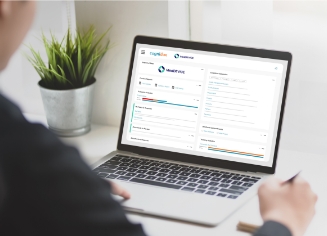.webp?width=750&name=shutterstock_596610626%20(1).webp) Does your Document Management System (DMS) apply the five Lean principles to the way you work?
Does your Document Management System (DMS) apply the five Lean principles to the way you work?
The classic book Lean Thinking, written by Womack and Jones in 1996, defined Lean as a system that helps companies:
"Identify value, line up value-creating actions in the best sequence, conduct these activities without interruption whenever someone requests them, and perform them more and more effectively."
And in many ways, this describes the role and purpose of a good document management system, too.
Womack and Jones propose five key principles of lean thinking for business, the most important of which is the identification and delivery of ‘customer value’.
What are the 5 Lean Principles?
- Identify value
- Create value streams
- Enable flow
- Establish Pull
- Pursue perfection
But how can these be mapped onto the functions of a good digital DMS?
How are lean principles applied in a good DMS
1. They identify and focus solely on customer value
Customer value should be the single-minded focus of any Lean Document Management System.
Value is “what the customer wants and only what the customer wants”
Obviously, customers derive no value from an uncontrolled development process that delays product releases and disrupts customer service. But neither do they derive value from the creation of unnecessary bureaucracies. A good DMS, therefore, clearly identifies, organises and makes available all the documents that are required for the efficient operation of a customer focused product development process.
2. They create value streams
Creating ‘Value Streams' is all about ensuring the ongoing removal of waste from processes so that product or services can proceed in the most effective and efficient way. The wasted time involved in a badly organised and understood development process is well documented. A great DMS, powered through a process driven intranet can help improve the way you operate, delivering leaner and more defined ways of working:
- Capture SOPs graphically
- Visualise process contingencies, gaps and opportunities
- Help you share and optimise best practice across the business
3. They enable flow
Removing waste as you create value streams - gives you clarity about exactly what needs to be achieved at each stage of a process to deliver end products that will satisfy customer demand.
The next step is to be sure the remaining steps flow smoothly with no interruptions, delays, or bottlenecks. A good DMS is powered by workflows that move documents seamlessly between people and teams for review and approval. Document holding features should help you gather groups of files together (such as product specs, plans and designs), automatically seeking approval from key stakeholders and publishing them together to trigger the next stage of a process or activity. The most efficient ‘Flow’ of a development process is enabled by the timely release of definitive documentation to which the whole business can refer.
4. They establish ‘pull’
Does everything in your business happen exactly when it needs to? Is your team always primed and ready to act at just the right moment in a production sequence in the most efficient way? Does capacity exactly match the demands on your resource? Or are you wasting time and effort deploying workers needed elsewhere to prepare documentation at vital times in the product cycle - for example to ready the organisation for inspection or audit.
‘Pull' is the 'just in time' principle, and it should be dictated by what your customers need and nothing else. Your customers need your product delivered to market to the required standards and exactly on time. A great DMS can ensure that key quality documentation (such as your DHF, technical file or quality manuals) are automatically indexed, organised and compiled as your development process progresses rather than as a labour intensive retrospective activity. That way, when it comes to audit, all the required files are available at the ‘touch of a button’, part of a ‘Lean pull system’ that maximises the efficiency of your team at exactly the moments they need it most.
5. They pursue perfection
“Perfection may sound like a request to focus on the ideal, but has more to do with using continuous reviews so that flows can adapt to changing customer requirements.”
A good DMS provides for a process of continuous improvement across your business. It enables this through its function as a repository of organisational knowledge - a resource outlining SOPs to which everyone refers and contributes to over time.
The best DMS are also used to prompt formal and trackable process reviews and optimisation cycles. This entails regular notifications for key stakeholders to check quality documentation still reflects what happens on the ground, suggesting changes when required and showing that regulatory requirements are continuing to be met and even exceeded. Once this process starts to happen customer-focused thinking can become ingrained; companies can be continually challenged to find new ways to innovate, reduce waste and improve the value of their offerings.
“The ultimate goal [of Lean thinking] is to provide perfect value to the customer through a perfect value creation process that has zero waste.”
Source: The Lean Enterprise Institute
It is said that up to 95% of process activities typically add no value for a company’s customers - and this can be especially true of many firms attempting to organise and control their documentation.
Where’s the customer value in spending months creating a bespoke eQMS with Sharepoint when that resource could be spent on product development? Where’s the value in spending time maintaining a failing DIY QMS solution with Google, or attending to the training and upkeep requirements of a massively complex on-premise system built for global corporations?
To prevent waste and satisfy your customers, you need a solution that is right-sized and prioritises the functions that are focused on delivering and optimising the value of your products in the market.





%20(1).webp?width=133&height=76&name=ISO%20IEC%2027001%20(1)%20(1).webp)